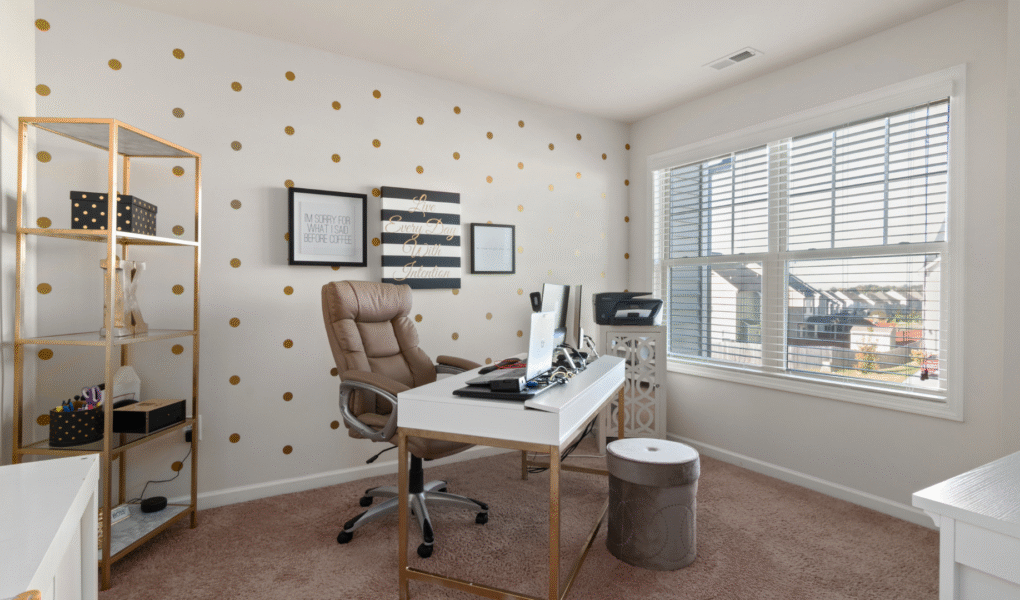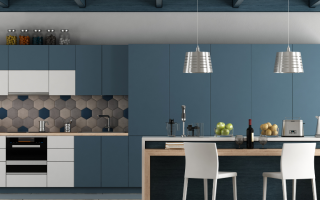Creating a productive home office is essential for anyone engaged in remote work. A well-designed workspace can significantly enhance focus, efficiency, and comfort, ultimately boosting productivity. Thoughtful home office design takes into account elements like layout, lighting, and ergonomics to support sustained work efforts.
Many homeowners now treat the home office as a planned room rather than an afterthought, and that intent shapes choices around desk height, lighting, and storage. Collaborating early with builders allows for built-in cabling, recessed shelving, and window placement that support both ergonomics and long-term comfort.
Working with home builders in Gainesville FL, or elsewhere, can streamline those decisions during the design phase so the workspace functions well without costly retrofits. These integrated choices help preserve the minimalist look while keeping the setup practical for daily use.
Also, incorporating the right furniture and technology can streamline tasks and minimize distractions. For example, investing in an ergonomic chair and desk can promote better posture and reduce fatigue. Additionally, personalizing the space with motivational decor can create a positive environment that encourages creative thinking.
To achieve the best results, one must consider both functionality and aesthetics. Organizing the workspace effectively allows for easy access to necessary tools while maintaining a clean look. By merging comfort with efficiency, anyone can transform their home office into a powerhouse of productivity.
Planning Your Productive Home Office
A productive home office starts with careful planning of space, needs, and layout. This involves selecting a dedicated space, defining individual workspace needs, and strategically positioning the desk to maximize efficiency.
Choosing a Dedicated Office Space
Selecting a dedicated office space is crucial for establishing a productive environment. Ideally, this space should be separate from living areas to minimize distractions. Consider rooms with natural light, as daylight can enhance mood and focus. If possible, choose a quieter part of the home to limit noise disturbances.
While existing rooms can be adapted, a spare bedroom or a sunroom might provide optimal conditions. Decluttering the space enhances focus and creates a more functional home office setup.
Defining Your Workspace Needs
Defining workspace needs ensures the office setup aligns with daily tasks. Identify essential tools and equipment, such as a computer, printer, and storage solutions. It’s vital to consider ergonomic furniture like adjustable chairs and sit-stand desks to promote comfort.
Storage should be easily accessible yet organized; shelves, cabinets, and filing systems can help maintain order. Also, incorporating elements of feng shui, such as appropriate colors and plants, can enhance the workspace’s energy and productivity.
Desk Placement and Room Layout
Desk placement and room layout are pivotal for a functional home office. Positioning a desk near a window can utilize natural light while providing a view for stimulation. The desk should face the entrance to foster a sense of control in the workspace. Leaving enough room to move around the desk encourages flexibility.
Incorporate multi-functional furniture to maximize space, such as tables that can store files or chairs that provide extra seating. Keeping the layout open yet organized facilitates workflow and maintains a modern home office atmosphere.
Beyond practical furniture choices, subtle spatial decisions can shape how you feel and work in a home office. Simple adjustments to traffic flow, balance between open and closed storage, and the placement of focal elements like a desk or plant can reduce stress and improve concentration. Thinking about these patterns helps you design a workspace that supports both creativity and calm; for a concise guide on these principles, see how room layout affects your mood. Applying a few of these ideas often yields immediate improvements in comfort and focus.
Optimizing Ergonomics and Comfort
Creating a productive home office requires attention to ergonomics and comfort. Proper furniture and accessories support health and efficiency. The right choices can lead to increased focus and reduced discomfort.
Selecting Ergonomic Furniture
Choosing ergonomic furniture is fundamental. An ergonomic chair provides proper lumbar support and promotes good posture. Features to consider include:
- Adjustable seat height
- Lumbar support
- Armrests that allow for relaxation
A desk should accommodate various tasks. Ergonomic desks often feature rounded edges and a height that allows for comfortable working positions. Seating and desktop arrangements should minimize strain on the back, neck, and eyes.
Adjustable and Standing Desk Options
Adjustable and standing desks cater to diverse needs. Sit-stand desks allow users to change positions throughout the day, promoting movement and reducing fatigue. Key advantages include:
- Improved circulation
- Reduced musculoskeletal issues
- Enhanced energy levels
When selecting a standing desk, ensure it is at elbow height when standing. This height encourages a neutral wrist position while typing. Regularly alternating between sitting and standing facilitates an ergonomic workflow.
Ergonomic Accessories for Productivity
Ergonomic accessories enhance office comfort and functionality. Key items include:
- Monitor stands to elevate screens to eye level
- Keyboard trays that allow for the correct wrist position
- Footrests to promote proper leg posture
Utilizing these accessories can significantly improve the workspace setup. They help maintain an efficient and comfortable posture, leading to better focus and productivity during work hours. By investing in ergonomic solutions, individuals support their well-being while enhancing their efficiency.
Enhancing Lighting, Organization, and Ambience
Effective home office design prioritizes lighting, organization, and a pleasant ambience. These elements work in harmony to create a productive workspace that fosters focus and creativity.
Maximizing Natural and Task Lighting
Natural light significantly impacts productivity. Placing the desk near windows maximizes exposure, reducing reliance on artificial lighting. Utilize sheer window treatments to diffuse sunlight while avoiding glare on screens.
To get consistent glare control and privacy without losing daylight, consider fitted window coverings in materials and opacities matched to your work habits; options like cellular shades, woven fabrics, or adjustable slat blinds can soften light while reducing reflections on screens.
Professional measurement and installation help eliminate gaps and ensure the treatment operates smoothly at desk height, which is especially useful in multi-window rooms. You can also explore motorized or easy-adjust controls to adjust light quickly during video calls or when shifting between sitting and standing. For homeowners in the Salt Lake City area, local companies specializing in Custom Blinds can provide tailored recommendations and accurate fitting guidance.
Task lighting is equally critical. Adjustable desk lamps provide focused illumination for reading and writing activities. Select LED fixtures that mimic daylight to enhance alertness. A combination of ambient and task lighting creates a balanced environment conducive to work, ensuring comfort throughout the day.
Smart Storage and Organization Solutions
Efficient storage solutions minimize clutter and enhance workflow. Incorporating wall-mounted shelves maximizes vertical space, providing easy access to books and supplies. Desk organizers and drawers should be categorized as items for quick retrieval.
Filing cabinets are essential for document organization. A clear labeling system aids in locating important paperwork when needed. Personal touches like a bulletin board or whiteboard help track tasks and inspire creativity, making the workspace functional and dynamic. Using a whiteboard marker to jot down reminders, deadlines, or motivational quotes can ensure the board stays versatile and easy to update as priorities change.
Incorporating Color, Décor, and Greenery
The color scheme can affect motivation and mood. Calming colors, such as soft blues or greens, promote concentration, while bold hues, like yellow, can energize. Decorative elements, including artwork and inspirational quotes, personalize the space, making it inviting.
Adding indoor plants introduces greenery, improving air quality and aesthetics. Options like snake plants or pothos require minimal maintenance. They also contribute to a serene environment, fostering productivity and wellness.
Creating a Distraction-Free Environment
A distraction-free workspace is vital for sustained focus. Select noise-canceling headphones to block out background noise if the home is lively. Additionally, using room dividers can create a sense of privacy, especially in shared spaces.
Rugs define the workspace and absorb sound, contributing to a quieter atmosphere. Personal touches like a gallery wall can motivate while creating a distinct work zone. Thoughtful design choices empower individuals to maintain concentration and achieve their productivity goals.
Leveraging Technology and Maintaining Work-Life Balance
Incorporating technology effectively can enhance productivity in a home office while also fostering a healthy work-life balance. Attention to cable management and the placement of devices plays a critical role in creating an organized workspace.
Integrating Technology for Productivity
Utilizing the right technology can transform a home office into a productive workspace. High-speed internet is essential for seamless communication and collaboration. Ergonomic monitors, wireless keyboards, and noise-canceling headphones can enhance comfort and focus. Smart lighting solutions, which adjust based on the time of day, can improve mood and energy levels.
Project management tools like Trello or Asana enable efficient task tracking, while cloud storage solutions offer secure data access. Incorporating these elements allows for a streamlined workflow and encourages creativity.
Managing Cables and Device Placement
Proper cable management is vital for a tidy and functional home office. Disorganized cables can create visual clutter and distract from productivity. Using cable trays or clips can keep wires neatly arranged. Choosing wireless devices reduces cable clutter, enhancing minimalism in design.
Strategically placing devices on a desk can maximize space and reduce strain. Positioning monitors at eye level and keeping widely used tools within reach promotes efficiency and comfort.
Supporting Work-Life Balance at Home
Establishing boundaries between work and personal life is crucial in a home office. Creating a designated workspace signals to the mind that it is time to work. Setting specific work hours and using tools like calendar reminders can help maintain this balance. When work is done, turning off technology signals a shift to personal time.
Incorporating elements like plants or art into the workspace can foster creativity and comfort. Regular breaks are essential for maintaining productivity and mental well-being.




